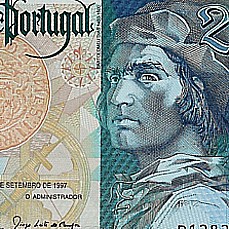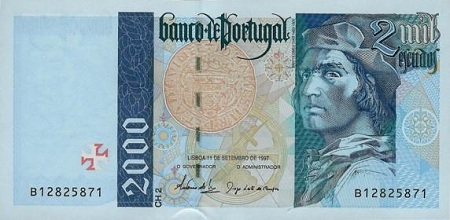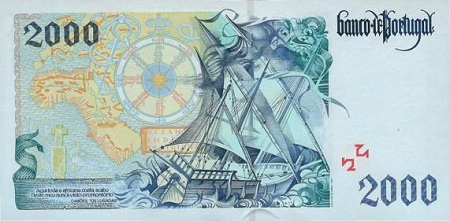PORTUGAL
Bartolomeu Dias

Bartolomeu Dias was a Portuguese explorer who captained the first ship to sail around the Cape of Good Hope at the southern end of Africa. In 1481, Bartolomeu Dias emerged from historical obscurity when he accompanied Diogo de Azambuja to explore Africa’s Gold Coast. Dias was a nobleman and supporter of the royal court, a superintendent of the Royal Warehouses, and was also a sailing master of a warship – the man of war Saint Christopher.
On October 10th, 1486, The Portuguese King John II assigned Dias as the head of an expedition to find a trade route to Asia by going south around the African continent, hoping to find an alternate trade route to avoid the time and extra cost of going through the middle east. This expedition also had a spiritual aspect; it was to try and find the land of the fabled Christian priest and king Prester John, which was supposed to be a Christian Kingdom of Abyssinia, lost amid Muslim lands, and thought to be in India and later in Ethiopia.
In April 1487, Bartolomeu Dias set sail from the Tagus River, below Lisbon, Portugal with a fleet of three ships, with the supply ship being captained by Bartolomeu’s brother, Pero. Six native Africans were brought along to help aid in translation with indigenous peoples along the way.
Dias sailed to the mouth of the Congo River, which was discovered only the year before by Diogo Cao and Martin Behaim. Then he followed the African coast to Walvis Bay where a violent storm caused him to lose sight of the coast for 13 days. This storm sent him well south of Walvis Bay and when it eased up, he set sail towards the continent and on February 3rd, 1488 he landed in what is today called Mossel Bay on the coast of South Africa. It was in Mossel Bay that they stocked up on fresh water and traded for livestock with the local inhabitants. These inhabitants were the KhoiKhoi, also known as Hottentots – named by the Dutch explorers, which means to stammer or stutter, because of their unusual clicking sounds in their language. Unfortunately, this word became derogatory and to mean ‘uncivilized and of inferior culture and intellect’. Soon after, Dias unknowingly rounded the Cape of Good Hope in a storm. He and his expedition were the first Europeans to venture this far.
Continuing on, Dias ventured eastward and landed in what is known today as Algoa Bay, where the crew threatened to mutiny due to a lack of supplies and that the continent had been rounded. Dias consented but also convinced them to sail on for a few more days. When this extra time had ended, the ship had reached a river that Dias called the Infante (supposedly after the captain of the second ship), which is today called the Great Fish River located on the eastern cape of South Africa. The coast had been going on to the north and east and the water had been getting warmer. Reaching this point, Bartolomeu Dias knew the coast had indeed been rounded and that India could easily be reached by this route and he turned back.
On March 12, 1488, Dias landed at what is known as Kwaaihoek, where the crew erected a limestone pillar brought from Portugal. This pillar was a symbol of Portuguese authority and Christianity. It was on this return trip that he actually discovered the Cape of Good Hope in May of 1488, which he originally called the Cape of Storms. It was Portuguese King John II who renamed it the Cape of Good Hope to avoid frightening wary sailors. The Cape of Good Hope is often thought to be the southernmost tip of the African continent, but that title actually belongs to Cape Agulhas. In December of 1488, Bartolomeu Dias was back in Portugal being gone for 16 months and 17 days. He explored over 1200 miles of unknown African coastline. Future Portuguese expeditions to the Indian Ocean by Christopher Columbus, Vasco de Gama and Pedro Cabral all used charts prepared by Bartolomeu Dias.
This was one of the worlds more important expeditions because, although it did not discover the Kingdom of Prester John, it did open a sea trade route with India and the rest of Asia which was quicker and cheaper than the overland route through the Middle East and the troubles with going through other countries.
Later in his life, Dias administered the Guinea Gold Trade until 1494 when the new king, Manuel I assigned Dias to supervise the building of two ships for Vasco de Gama. In 1497, Dias joined Vasco de Gama his expedition to India. Dias followed de Gama in a ship as far as the Cape Verde islands, and then turned off to Guinea. In 1500 Dias also joined Pedro Cabral on a 13 vessel expedition to the Indian Ocean. Bartolomeu Dias was in charge of 4 ships and was charged with establishing a port in Sofala (in Zimbabwe). This voyage was to India, but ventured widely south-westward and discovered Brazil. On May 2nd, 1500, then left Brazil and from May 12th to May 23rd a comet was seen. On May 24th, a storm came up and sank four ships and killed all hands, including Bartolomeu Dias on May 29th, 1500 when his ship sank not far form the Cape of Good Hope.
He has been honored on many stamps and is the only Portuguese to be on two Portuguese Escudo banknotes.

